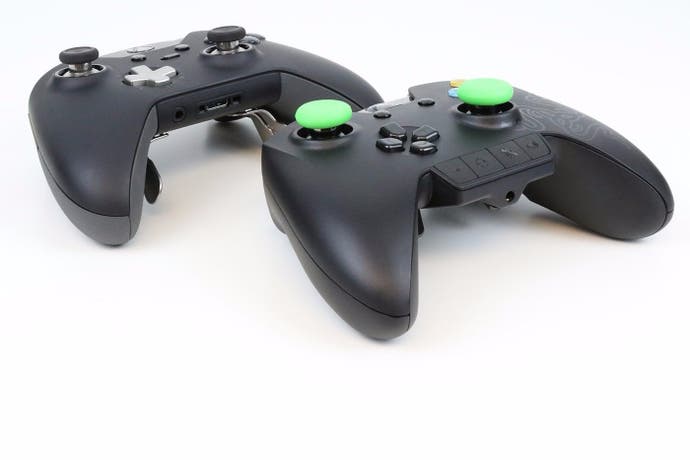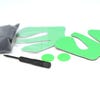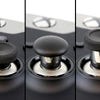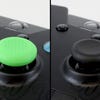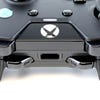Face-Off: Microsoft Xbox Elite controller vs Razer Wildcat
Can premium-priced controllers make you a better player?
At Digital Foundry we often talk about hardware upgrades that can dramatically improve the gameplay experience, but there's a fundamental component that is often overlooked: the controller. As the primary input device for console gamers, this is the core component in how we interact with our games, working to connect us with the action on-screen and to deliver feedback across the course of play. A great controller connects you more closely with the game, while a flawed one does the opposite, actively impacting the quality of gameplay - as any fighting game fan forced to use the Xbox 360 controller's d-pad will tell you.
Revised over three generations, the Xbox One controller comfortably caters to all genres and in many ways improves upon the standard set by the decade-old Xbox 360 pad. But the question is this: are there better options available for dedicated gamers who want to seek out every last bit of gameplay performance available? Both Microsoft and Razer certainly think so, with the Xbox One Elite controller and the Razer Wildcat positioned as premium products aimed at getting the most out of your games.
With both pads costing around £120, they are obviously aimed at the high-end market. The price may seem extreme in both cases, but paying top dollar for an improved interface is nothing new in the PC market - and as we shall discover, it does improve gameplay. There's an enhanced feature set available too: both feature customisable parts and the ability to re-map buttons to provide an experience that is more suited to your own style of play. Both controllers provide a number of improvements over the stock pad, though the Elite takes point in terms of overall features and functionality.
Buy the controllers tested on this page from Amazon with free shipping:
Build quality and design
The Elite takes the same design used for the standard Xbox One pad and further refines it. Plastics are replaced with metallic parts, not only giving the pad a premium feel, but also serving to increase durability. The use of rubberised surfaces across the controller also provides excellent grip during frenetic gaming sessions. However, the triggers, face-buttons, and bumpers closely mirror those found on the standard Xbox One pad.
By comparison, build quality on the Razer Wildcat feels cheaper than the Elite and even the standard Xbox One pad, despite its premium price point. Lightweight plastics are used here, and the face-buttons tend to rattle when vibration motors are working. However, the core materials still feel capable of standing up to punishment, while the lightweight construction makes for a comfortable hold over extended use. The Wildcat is a lot lighter than the Elite, and features slightly less heft than the standard Xbox One controller.
Rubberised covers are also supplied for the controller for those who want extra grip, but these come in the form of adhesive materials that need to be manually attached and removed, and this isn't a particularly easy task. Rubber analogue stick covers are also supplied to improve grip here, and work fairly well - these can be removed and reapplied easily without issue. Probably the biggest difference between these pads is that the Elite offers both wired and wireless functionality, while the Wildcat is a wired controller only. We're not big fans of the micro-USB connection used on the Elite - it's too fragile, lacking durability. For its part, Razer uses its own more robust socket, but for many, the lack of wireless functionality is going to be a problem.
Customisable features
Both controllers' key selling point is the ability to customise key features to suit individual needs. On the Elite, these come in the form of four paddles that sit underneath the controller, along with swappable d-pads and analogue sticks. By comparison, the Wildcat features two removable digital triggers located in a similar position, and two extra bumpers located in the shoulder of the pad. Both feature hair trigger stops that shorten the travel range of the triggers for faster operation.
The use of extra buttons and paddles is a superb idea on both controllers, and these really come to the forefront in first-person shooters and driving games, where functions such as changing gear or reloading are a perfect fit here, freeing up your thumbs to pull off other functions. In this area the Elite has an advantage over the Wildcat. The paddles are more ergonomically located on the underside of the controller, and there are four of them. By contrast, the Wildcat only has two in a similar position. Instead, the third and fourth extra buttons are deployed as shoulder bumpers, which are hard to reach, limiting their usefulness. That said, on our Elite controller, the lower paddles did get stuck on the ones above during gameplay - seating both sets perfectly takes a few attempts to get right, but even then we couldn't fully resolve the issue.
In terms of customising controller layout, the Xbox Accessories app allows you to fully re-map the buttons on the Elite controller, along with adjusting sensitivity of the analogue sticks and increasing the dead zone of the triggers. Multiple profiles can be created and stored on the console, allowing you to create custom set-ups for each game. Only two of these profiles are stored on the controller at any one time, with the user able to switch between each one. The feature is excellent and saves you from having to keep changing settings when switching between games. Indeed, it's possible to open up the Xbox Accessories app mid-game and change setting on the fly, making finding your sweet spot a relatively painless process.
The Wildcat and standard Xbox One controllers also take advantage of the Xbox Accessories app's added customisability, although features are limited to button remapping functions only. On the Wildcat it's possible to remap functions to the extra triggers and bumpers using functionality built into the controller at any time, but the standard buttons and triggers can only be remapped using the accessories app. In comparison, all of the remapping options are tied to the Xbox Accessories App for the Elite controller, putting all user customisation in one place. The Elite clearly has a more comprehensive feature set here. However, the Wildcat has built in headset audio controls allowing you to mute players and adjust volume - a feature that requires use of a separate adaptor when using the Elite and standard Xbox One pads. It's a nice touch and something one would expect to see on a high-end gaming controller as standard.
Analogue stick customisation and performance
The Elite's analogue sticks and user customisation options are really something special. The analogue sticks are magnetically held into place and can be swapped out on the fly at any time, with Microsoft including three different designs in the box. Sensitivity is adjustable to a granular level using the Xbox Accessories app, with a number of different manually adjustable presets. Finding the right stick and sensitivity combination takes time, and these may need to be tweaked on a per game basis. However, once you've found a set-up that works for you, the results are impressive.
Mileage varies from player to player, but after making a few quick adjustments, we were able to improve gameplay performance in both Start Wars Battlefront and Battlefield Hardline by better tracking fast-moving enemies. This noticeably upped a mediocre kill ratio - a surprisingly positive result. While the Elite controller won't turn an average FPS player into an eSports champion, gameplay performance improves simply due an improved interface between player and game - and this is probably the biggest upgrade over the stock Xbox One pad.
This is one area where the Wildcat isn't so impressive. Razer's offering doesn't feature any form of analogue stick customisation, although the sticks offer up a touch more refinement in terms of responsiveness and general control over the standard Xbox One controller, but difference here is minuscule compared to what you can achieve using the Elite's extensive sensitivity options. There's an improvement in the gameplay experience, but tangible results in-game weren't anything like as pronounced as they were with the Elite. The wider diameter sticks on the Wildcat feel great to the touch though, and are well-suited for those with larger fingers. However, the sticks lack grip, and while the included rubber covers help to reduce their slipperiness, the added bulk doesn't feel quite right.
D-pad options and performance
The d-pad on the standard Xbox One controller is generally excellent and the same version is available to use on the Elite, performing to the same high standard. Fighting games are fun to play and quarter circle-type moves are easy to pull off consistently. The new circular attachment performs even better, with the experience feeling quite similar to an arcade-style thumb pad. However, you have to be quite gentle with it: firm pressure causes part of the d-pad to detach from the controller housing, and this is very off-putting during play. We found the standard cross-shaped option to be the most consistent performer for heavy fighting game sessions.
Razer's Wildcat controller is aimed primarily at the first-person shooting audience, and that is clearly apparent with the poorly designed d-pad. Here four separate directional buttons replace the traditional d-pad. These have a somewhat cheap feel and are only suitable for rudimentary play, so simple moves in Dead or Alive are easy enough to pull off, but complex combos and fireball-type motions are out of its scope, realistically. The experience is poor even compared to the dire Xbox 360 controller's d-pad. However, it does work well for selecting weapons or switching between abilities in FPS titles, its primary design point. Even so, the lack of a proper d-pad is disappointing to see on a high-end controller boasting a premium price tag, and that's a shame as the face-buttons are on another level compared to the Elite controller.

Buttons and triggers breakdown
The face-buttons are a key highlight of the Wildcat. These have a mechanical feel and significantly less travel than the Elite equivalents, translating to super-responsive button presses that benefit fighting games and action titles. On the other hand, the Elite's face-buttons are an exact match for the ones used on the standard controller and work well. However, we feel that Microsoft could have taken things further in this area given the dramatic improvements seen on the competition.
When it comes to the analogue triggers, both feature hair trigger functionality. This option reduces travel and range, making it possible to fire weapons in a faster and more controlled manner in FPS titles. In addition to this, the Wildcat allows you to select a higher sensitivity option for the triggers too. This adds a subtle layer of extra responsiveness over the default triggers on both Microsoft's controllers. Conversely, there's no way to increase sensitivity on the Elite controller - only the option of enlarging the dead zone, which has the opposite effect.
Microsoft Elite Controller vs Razer Wildcat: the Digital Foundry verdict
The standard Xbox One controller provides a solid base, and works well across a wide range of titles, but there's plenty of room for enhancement and this is where premium controllers really add value. The bottom line is that both of these pads are clearly superior to the standard controller, and do indeed improve gameplay, connecting you more closely to the experience.
The Razer Wildcat offers up a touch more refinement in terms of responsiveness and general control over the standard Xbox One pad and the default Elite controller set-up. It's a great pad and works very well, with its lightweight build quality and extra features improving the way shooting and racing games play. The built in audio controls are also a nice touch absent on Microsoft's official controllers. However, it doesn't quite pack all the features required to transform the gameplay experience in all areas. This is something the Elite controller achieves beautifully.
Boasting a much wider range of customisable parts and more granular adjustments for sensitivity, the Xbox One Elite controller is the superior pad all round and quite possibly the best pad money can buy right now. It offers up more features and better build quality at a similar price-point to the Razer Wildcat, and nothing else really comes close. Here, the ability to swap out analogue sticks and adjust sensitivity is a real game changer, actually helping to make us into better players as a result.
On the whole, the Wildcat is still a good alternative for those who primarily play FPS titles, but if you're in the market for a high-end controller for both Xbox One and PC gaming, and one that provides superb results on a range of gaming genres, the Elite is quite possibly the best on the market right now. While the high price-point will be a barrier to entry to many, the improvement to gameplay is certainly worthwhile, and those heavily invested in competitive play would be wise to consider the benefits.
